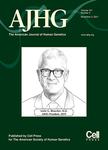版权所有:内蒙古大学图书馆 技术提供:维普资讯• 智图
内蒙古自治区呼和浩特市赛罕区大学西街235号 邮编: 010021

作者机构:Case Western Reserve Univ Dept Epidemiol & Biostat Cleveland OH 44109 USA PPGx Inc La Jolla CA USA
出 版 物:《AMERICAN JOURNAL OF HUMAN GENETICS》 (美国人类遗传学杂志)
年 卷 期:2000年第66卷第1期
页 面:216-234页
核心收录:
学科分类:0710[理学-生物学] 07[理学] 09[农学]
基 金:NCI NIH HHS [CA73270 R29 CA073270] Funding Source: Medline
主 题:.noncoding distributions American populations single-nucleotide SNP allele allele-frequency Hispanic Chinese American average minor-allele pairs of SNPs
摘 要:Single-nucleotide polymorphisms (SNPs) may be extremely important for deciphering the impact of genetic variation on complex human diseases. The ultimate value of SNPs for linkage and association mapping studies depends in part on the distribution of SNP allele frequencies and intermarker linkage disequilibrium (LD) across populations. Limited information is available about these distributions on a genomewide scale, particularly for LD. Using 114 SNPs from 33 genes, we compared these distributions in five American populations (727 individuals) of African, European, Chinese, Hispanic, and Japanese descent. The allele frequencies were highly correlated across populations but differed by 20% for at least one pair of populations in 35% of SNPs. The correlation in LD was high for some pairs of populations but not for others (e.g., Chinese American or Japanese American vs. any other population). Regardless of population, average minor-allele frequencies were significantly higher for SNPs in noncoding regions (20%-25%) than for SNPs in coding regions (12%-16%). Interestingly, we found that intermarker LD may be strongest with pairs of SNPs in which both markers are nonconservative substitutions, compared to pairs of SNPs where at least one marker is a conservative substitution. These results suggest that population differences and marker location within the gene may be important factors in the selection of SNPs for use in the study of complex disease with linkage or association mapping methods.